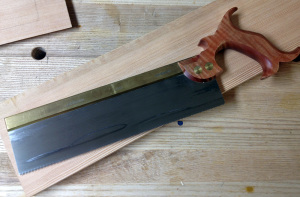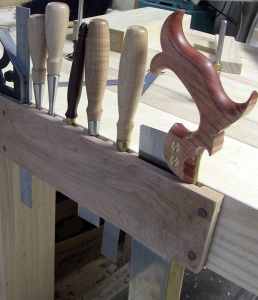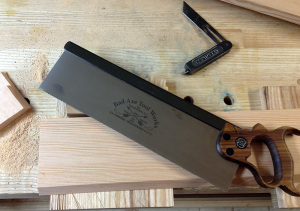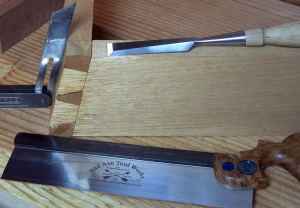Upgrading a Hand Saw
 In the power tool world the expression, “buy your last tool first” is a pretty common way to say that scrimping on tools will end up costing you more in the long run. Lack of capacity or power, and/or poor performance inevitably will force the woodworker to upgrade to a better tool. The hand tool world is not immune to this phenomenon and you will often find woodworkers looking for a better dovetail saw or better jack plane. Unlike power tools this “upgrade” has little to do with capacity; moreover, the “upgrade” isn’t due to an under performing tool but a realization in your own working style.
In the power tool world the expression, “buy your last tool first” is a pretty common way to say that scrimping on tools will end up costing you more in the long run. Lack of capacity or power, and/or poor performance inevitably will force the woodworker to upgrade to a better tool. The hand tool world is not immune to this phenomenon and you will often find woodworkers looking for a better dovetail saw or better jack plane. Unlike power tools this “upgrade” has little to do with capacity; moreover, the “upgrade” isn’t due to an under performing tool but a realization in your own working style.
 Back when I was just dabbling with hand tools and still relying heavily on power tools for milling and sizing of stock, I bought this Lie Nielsen Carcass Saw. It is an 11″ long blade filed crosscut at 14 ppi. I used it a lot for cutting tenon shoulders, dados, and sometimes cutting smaller boards to length. It became the most used saw in my nest to the point where I made a bench side storage rack designed to store the saw along with a few common chisels.
Back when I was just dabbling with hand tools and still relying heavily on power tools for milling and sizing of stock, I bought this Lie Nielsen Carcass Saw. It is an 11″ long blade filed crosscut at 14 ppi. I used it a lot for cutting tenon shoulders, dados, and sometimes cutting smaller boards to length. It became the most used saw in my nest to the point where I made a bench side storage rack designed to store the saw along with a few common chisels.
Now, 4 years later I find myself working entirely by hand. All my milling and piece sizing is done from rough sawn down to final sizes with saws and planes. My working style demands more from my carcass saw because it cuts larger boards and more joinery that was previously cut with some powered assistance. Don’t get me wrong, my little Lie Nielsen carcass saw still works like a dream but I have been thinking a lot about how I might upgrade to a tool more suited to the heavy cross cutting load I place on it.
First of all I want a longer plate. When you first start sawing you feel like you have more control over a shorter plate but as you get better and start to trust the straightness of the plate, you want more lengths to quickly span across boards and to cut faster.
Second, since I now bring my parts to final size by hand, I am making more through cuts that require precision on a much greater sizes of pieces. Cutting through a board requires more speed that comes from a lower pitch in the teeth plus some greater consideration towards the set of the teeth to clear the sawdust while tracking in the kerf straight and true. Of course with deeper cuts comes the need for more saw plate under the back.
Even the hang and the fit of the handle change. Longer, deeper cuts mean that greater precision is needed on the first couple of strokes to ensure you get a square and plumb cut.
 So armed with this list of things, I headed to my favorite saw pimp, Bad Axe Toolworks. In more traditional saw terms, what I wanted was a sash saw. This is the big brother to the carcass saw with a little more oomph and capacity that blends speed and power with high precision and a clean cut. Of course working at a lumber yard has its perks too in the form of some 5/4, quartersawn Teak for the handle.
So armed with this list of things, I headed to my favorite saw pimp, Bad Axe Toolworks. In more traditional saw terms, what I wanted was a sash saw. This is the big brother to the carcass saw with a little more oomph and capacity that blends speed and power with high precision and a clean cut. Of course working at a lumber yard has its perks too in the form of some 5/4, quartersawn Teak for the handle.
A ridiculously short couple of months later and I had this beautiful Bad Axe Sash saw on my doorstep. I have been using it exclusively for more than a month now and I could not be happier. I have said this so many times before, but Bad Axe saws cut like they are on rails. The handle hugs my hand and the balance is so perfect that it feels like an extension of my hand. I point and it saws.  Having just finished filming a Hand Tool School lesson on compound dovetails I was able to put the sash to the test outside of the happy and safe world of 90 degree cuts. The longer reach of the saw allowed me to “connect the dots” on some weird compound angles without a thought and left a surface clean enough that my block plane polished it in seconds. Of course I would be remiss in mentioning that the dovetails themselves were actually cut using my Bad Axe Dovetail saw. That is a joygasm unto itself!
Having just finished filming a Hand Tool School lesson on compound dovetails I was able to put the sash to the test outside of the happy and safe world of 90 degree cuts. The longer reach of the saw allowed me to “connect the dots” on some weird compound angles without a thought and left a surface clean enough that my block plane polished it in seconds. Of course I would be remiss in mentioning that the dovetails themselves were actually cut using my Bad Axe Dovetail saw. That is a joygasm unto itself!
So my Lie Nielsen Carcass saw has been downsized and moved off my bench into the rack. This new Sash saw that was customized to my working style has replaced it. Too bad I created that bench side storage specifically to fit my smaller Lie Nielsen saw!


